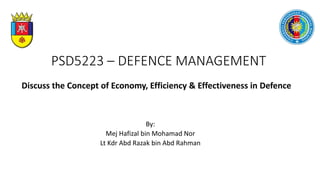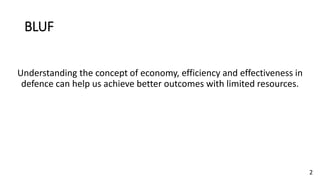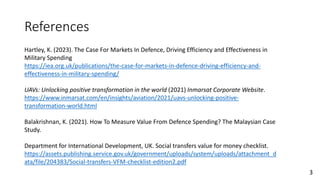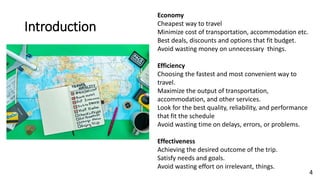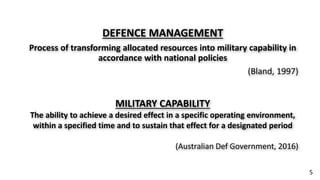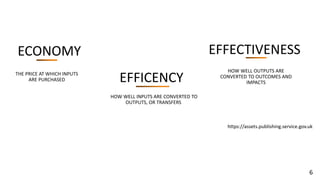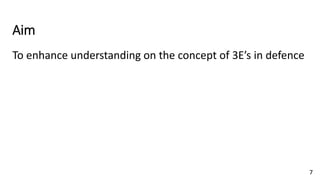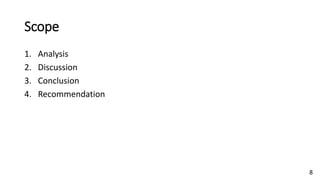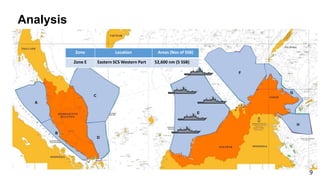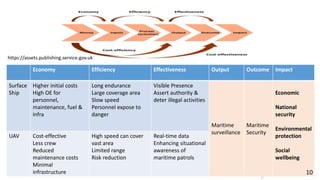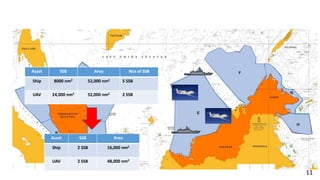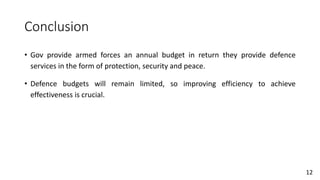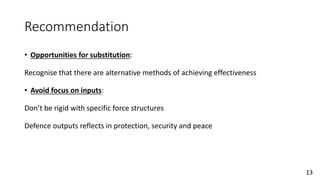Concept 3E's in Defence by Hafizal&Razak (2024).pptx
- 1. PSD5223 – DEFENCE MANAGEMENT By:​ Mej Hafizal bin Mohamad Nor Lt Kdr Abd Razak bin Abd Rahman Discuss the Concept of Economy, Efficiency & Effectiveness in Defence
- 2. BLUF Understanding the concept of economy, efficiency and effectiveness in defence can help us achieve better outcomes with limited resources. 2
- 3. Hartley, K. (2023). The Case For Markets In Defence, Driving Efficiency and Effectiveness in Military Spending https://iea.org.uk/publications/the-case-for-markets-in-defence-driving-efficiency-and- effectiveness-in-military-spending/ UAVs: Unlocking positive transformation in the world (2021) Inmarsat Corporate Website. https://www.inmarsat.com/en/insights/aviation/2021/uavs-unlocking-positive- transformation-world.html Balakrishnan, K. (2021). How To Measure Value From Defence Spending? The Malaysian Case Study. Department for International Development, UK. Social transfers value for money checklist. https://assets.publishing.service.gov.uk/government/uploads/system/uploads/attachment_d ata/file/204383/Social-transfers-VFM-checklist-edition2.pdf References 3
- 4. 4 Introduction Economy Cheapest way to travel Minimize cost of transportation, accommodation etc. Best deals, discounts and options that fit budget. Avoid wasting money on unnecessary things. Efficiency Choosing the fastest and most convenient way to travel. Maximize the output of transportation, accommodation, and other services. Look for the best quality, reliability, and performance that fit the schedule Avoid wasting time on delays, errors, or problems. Effectiveness Achieving the desired outcome of the trip. Satisfy needs and goals. Avoid wasting effort on irrelevant, things.
- 5. DEFENCE MANAGEMENT Process of transforming allocated resources into military capability in accordance with national policies (Bland, 1997) MILITARY CAPABILITY The ability to achieve a desired effect in a specific operating environment, within a specified time and to sustain that effect for a designated period (Australian Def Government, 2016) 5
- 6. https://assets.publishing.service.gov.uk THE PRICE AT WHICH INPUTS ARE PURCHASED EFFICENCY ECONOMY EFFECTIVENESS HOW WELL INPUTS ARE CONVERTED TO OUTPUTS, OR TRANSFERS HOW WELL OUTPUTS ARE CONVERTED TO OUTCOMES AND IMPACTS 6
- 7. To enhance understanding on the concept of 3E’s in defence Aim 7
- 8. Scope 8 1. Analysis 2. Discussion 3. Conclusion 4. Recommendation
- 9. Analysis Zone Location Areas (Nos of SSB) Zone E Eastern SCS Western Part 52,600 nm (5 SSB) 9
- 10. 10 Economy Efficiency Effectiveness Output Outcome Impact Surface Ship Higher initial costs High OE for personnel, maintenance, fuel & infra Long endurance Large coverage area Slow speed Personnel expose to danger Visible Presence Assert authority & deter illegal activities Maritime surveillance Maritime Security Economic National security Environmental protection Social wellbeing UAV Cost-effective Less crew Reduced maintenance costs Minimal infrastructure High speed can cover vast area Limited range Risk reduction Real-time data Enhancing situational awareness of maritime patrols https://assets.publishing.service.gov.uk 10
- 11. Asset SSB Area Nos of SSB Ship 8000 nm2 52,000 nm2 5 SSB UAV 24,000 nm2 52,000 nm2 2 SSB Asset SSB Area Ship 2 SSB 16,000 nm2 UAV 2 SSB 48,000 nm2 11
- 12. Conclusion • Gov provide armed forces an annual budget in return they provide defence services in the form of protection, security and peace. • Defence budgets will remain limited, so improving efficiency to achieve effectiveness is crucial. 12
- 13. Recommendation • Opportunities for substitution: Recognise that there are alternative methods of achieving effectiveness • Avoid focus on inputs: Don’t be rigid with specific force structures Defence outputs reflects in protection, security and peace 13
- 14. Q&A 14
Editor's Notes
- #2: Assalamualaikum and good morning I bid to our Honourable Kdr Dr Haliza and my fellow collegue Today, I together with Major Hafizal would like to present and Discuss the Concept of Economy, Efficiency & Effectiveness in DefenceĚý​
- #3: In this presentation, we will discuss the concept of economy, efficiency and effectiveness in defence and how they can help us achieve better outcomes with limited resources. We will also provide some examples and recommendations for improving the defence policy and planning in the current and future scenarios. By the end of this presentation, it is our hope that we will have a better understanding of the key factors and challenges that affect the defence performance and how toĚýaddressĚýthem.
- #5: Imagine you are planning a trip to a foreign country. You have a limited budget and time, and you want to make the most of your trip. How do you decide where to go, what to do, and how to travel? Economy in defence is like finding the cheapest way to travel to your destination. You want to minimize the cost of your transportation, accommodation, and other expenses. You look for the best deals, discounts, and options that fit your budget. You avoid wasting money on unnecessary or overpriced things. Efficiency in defence is like choosing the fastest and most convenient way to travel to your destination. You want to maximize the output of your transportation, accommodation, and other services. You look for the best quality, reliability, and performance that fit your schedule. You avoid wasting time on delays, errors, or problems. Effectiveness in defence is like achieving the desired outcome of your trip. You want to satisfy your needs, preferences, and goals. You look for the best fit, suitability, and relevance of your destination, activities, and experiences. You avoid wasting effort on irrelevant, incompatible, or unsatisfactory things. By applying the concept of economy, efficiency and effectiveness in defence, you can plan a trip that is optimal, rational, and beneficial for you. Similarly, by applying the concept of economy, efficiency and effectiveness in defence, you can design a defence policy and plan that is optimal, rational, and beneficial forĚýyourĚýcountry.
- #9: These are our scope today that will be focusing on understanding the theory through its application
- #11: Surface Ship Economy: Cost of Acquisition: Surface ships typically have higher initial procurement costs due to their size, construction, and specialized equipment. However, once acquired, they can serve multiple purposes (e.g., patrol, search and rescue, cargo transport). Operating Expenses: Surface ships require ongoing expenses for crew salaries, maintenance, fuel, and infrastructure (ports, docks, repair facilities). These costs can be substantial over the ship’s lifetime. Resource Allocation: Deploying surface ships involves allocating resources (personnel, fuel, maintenance) that impact the overall defense budget. Efficiency: Endurance: Surface ships can operate continuously for extended periods, providing a persistent presence in maritime areas. Their endurance allows for long patrols and surveillance missions. Adaptability: Ships can carry diverse payloads, including radar systems, sonar, and communication equipment. They can be customized for specific tasks. Response Time: Surface ships are always on standby, ready to respond to emergencies or incidents. Their proximity to coastal regions enables rapid deployment. Effectiveness: Visible Deterrence: The presence of surface ships asserts authority and deters illegal activities. Their visibility sends a strong message to potential threats. Multi-Role Capability: Surface ships can engage in various roles, such as enforcing maritime laws, conducting search and rescue operations, and supporting naval warfare. Human Decision-Making: Manned ships allow for real-time decision-making by experienced crews. They can adapt to dynamic situations and assess risks. UAV Economy: Cost-Effective Deployment: UAVs offer a cost-effective alternative to manned surface ships. They require fewer crew members, no onboard facilities (such as living quarters), and reduced maintenance costs. Fuel Efficiency: UAVs operate on electric or hybrid propulsion systems, which are more fuel-efficient than traditional marine diesel engines used in ships. This translates to lower operational costs. Reduced Infrastructure: Unlike surface ships that need ports, docks, and maintenance facilities, UAVs can be launched and recovered from smaller bases or even mobile platforms, reducing infrastructure requirements. Efficiency: Persistent Surveillance: UAVs can fly for extended periods without crew fatigue, providing continuous surveillance over vast maritime areas. This persistence allows them to monitor shipping lanes, detect anomalies, and track vessels over long durations. Rapid Deployment: UAVs can be rapidly deployed in response to emerging threats or incidents. They can cover large distances quickly, reaching remote areas faster than surface ships. Adaptive Sensor Suites: UAVs can carry various sensors (such as radar, cameras, and infrared) tailored to specific surveillance needs. These sensors can be reconfigured or upgraded easily, adapting to changing operational requirements. Effectiveness: Enhanced Situational Awareness: UAVs provide real-time data, enhancing the overall situational awareness of maritime patrols. They can identify vessels, monitor illegal activities (such as smuggling or piracy), and track suspicious behavior. Coordinated Operations: UAVs can collaborate with surface ships, sharing information and coordinating responses. For example, a UAV can detect a vessel of interest and guide a nearby surface ship for interception. Risk Reduction: By deploying UAVs, human operators can avoid direct exposure to dangerous situations. UAVs can assess risks, conduct reconnaissance, and gather intelligence without risking human lives.
- #13: Governments award their armed forces an annual budget in return for which they provide defence services in the form of protection, security and peace. The armed forces have the task of converting the defence budget into a force structure capable of protecting a nation’s property rights over its air, land and sea domains, ultimately providing protection for its population, their assets and freedoms. Economics will remain important to the military. Defence budgets will remain limited, so improving efficiency to achieve effectiveness is crucial.
- #14: We recognises that there are alternative methods of achieving protection. There are many examples of substitution possibilities in the armed forces. These include reserve forces replacing regular forces; drones replacing manned aircraft (e.g. for maritime patrol roles). It is not suggested that these are all examples of perfect substitutes; some are imperfect and limited substitutes. For example, it will be claimed that the country needs an army of 80,000 soldiers, a 25-ship navy and a 50-squadron air force. This is the wrong focus since the emphasis is on inputs rather than defence outputs as reflected in protection, security and peace.
